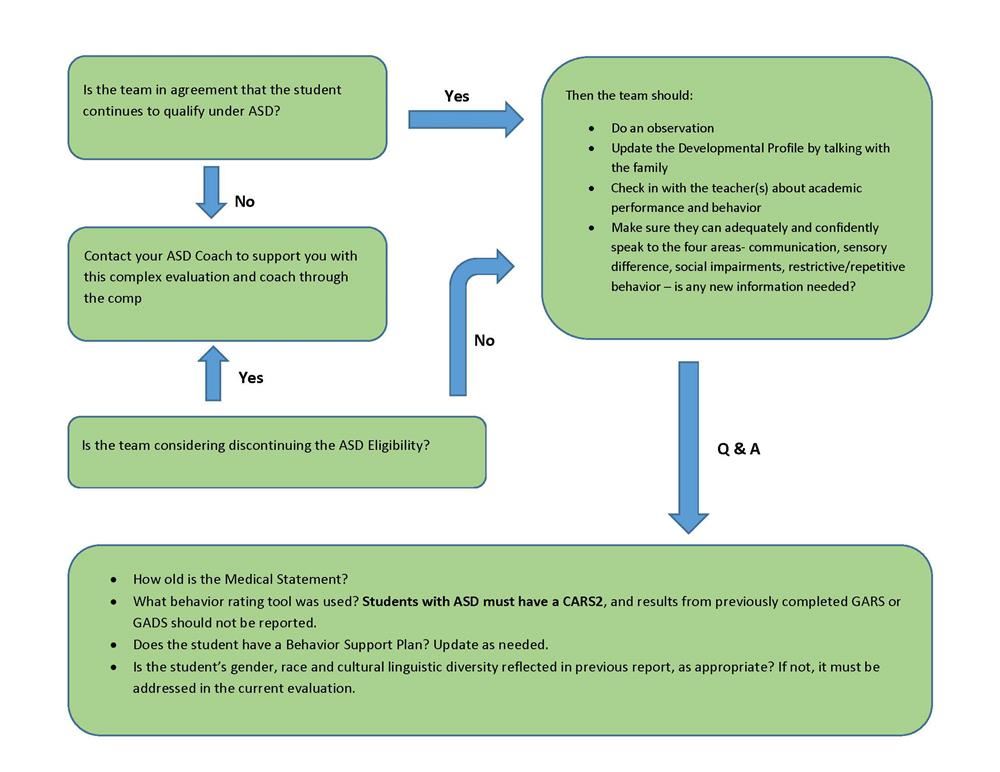-
Evaluations and Reevaluations
Autism Spectrum Disorder Technical Assistance Paper
This page provides information on Evaluations, Reevaluations, and Complex Evaluations.
While the research is relatively new in this field, it is clear that nationwide, as well as within PPS, there are subgroups who are under-identified with an medical diagnosis or educational eligibility of ASD. Specifically, our culturally and/or linguistically diverse students, students of color and girls are being under identified as having an educational eligibility of ASD. Please contact your autism coach if you would like to read some literature around ASD evaluations and our historically underserved students. If you are supporting an evaluation for a student who has been historically under identified as a student with ASD, contact your Autism Coach, for consultation and support.The following is a checklist for teams to use adapted from the the work of Harris, Barton, & Albert (2014). This checklist includes eleven quality indicators of a culturally and linguistically inclusive assessment. As a team, please consider where in your evaluation components (e.g. developmental history, observations, etc) you are able to gather, consider and reflect on these critical quality indicators.
PPS Checklist for Assessing the Cultural Relevancy of an ASD Evaluation - PDF
Evaluation Components
The OARs, the TAPS (2009) and the Oregon Commission on Autism have outlined the necessary components of an ASD evaluation. An evaluation is treated as an initial evaluation when ASD is being considered as an educational eligibility for the first time or a team is determining if a student no longer meets the educational criteria for ASD. Use the following checklist to track the evaluation process, team collaboration and dates.Developmental ProfileThe purpose of this component is to document historical and current characteristics of ASD associated with the four areas. Components may include:- Developmental interview of parent or caregiver
- Review of records (medical reports, previous evaluations, current or previous IEPs, other relevant reports
- Interview with teacher and staff
PPS Parent Interview - PDF (editable)PPS ASD Teacher Interview - PDF (editable)Observations- Three observations (minimum of 20 minutes each)
- Over more than one day in multiple settings
- One to include direct interaction with the student
Physician Statement- Provides the status of the student's general health
- Identifies other conditions (such as hearing loss, TBI, etc.) that may be confused with ASD, when ASD is not actually present
- Identifies medical conditions or genetic syndromes that may (or may not) be associated with ASD
Communication Assessment to Address Communication Characteristics of ASDFunctional communication assessments are generally more functional and qualitative than those for traditional language evaluations, which are more qualitative and concise. Standardized measures are not required, but can be used where appropriate. Functional communication components may include:- Pragmatic checklists - informed by your observation(s) and interactions with student, and checklists completed by classroom teacher to rate functional communication within the classroom
- Standardized measures of pragmatics and social thinking
- Informal measures: double interview, narrative sampling, language sampling, etc.
- Standardized measures of language content and form when appropriate (i.e.e, suspect other language deficits, or to document discrepancy within the broad domain of "language."
Behavior Rating ToolsAlthough the TAPS (2009) lists a number of acceptable Behavior Rating Tools, the field was narrowed considerably by the Oregon Commission on Autism (2010). In alignment with the state, Portland Public Schools considers the CARS2, ASIEP-3 and ADOS-2 to be "research based - autism-specific instrument(s)."CARS2The CARS2 is a summative tool done after data has been collected and all other assessments are completed.- Scores are based on qualitative and quantitative data. All scores are backed up by information gathered throughout the assessment.
- The tool provides a standardized score, although it is only documents characteristics of autism, not time/intensity or discrepancies.
- The CARS2 is not a definitive tool in determining eligibility, simply one more piece of information to be considered in painting a picture of the student.
Documentation of impact or Disability:Consider all of the following:- Academic areas
- Non-academic areas
- Progress in meeting goals based on the general education curriculum
- Performance on Statewide and local assessments
Documentation of Educational Needs:Additional information to help identify specific skills, strengths, and needs for specialized instruction.- How does the child learn more information?
- What is reinforcing for the child?
- What doest he child find aversive?
- What are the child's interest areas?
Reevaluations
When conducting a reevaluation, not all components of an initial eligibility are required. Please see this checklist for more information about what components are required and what additional information may support the reevaluation, as well as program development.Revaluation planning tool (Updated 2019)

-
Complex Evaluation
For information regarding complex evaluations please contact your autism coach. See the Special Education Organizational chart to find your autism coach


